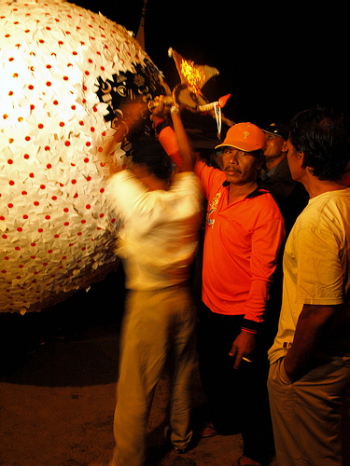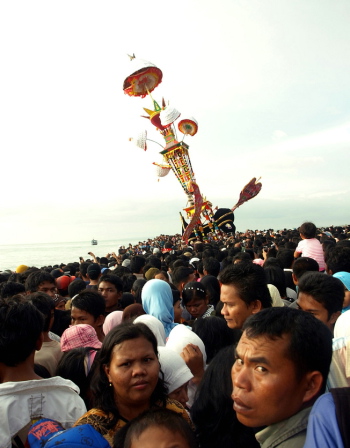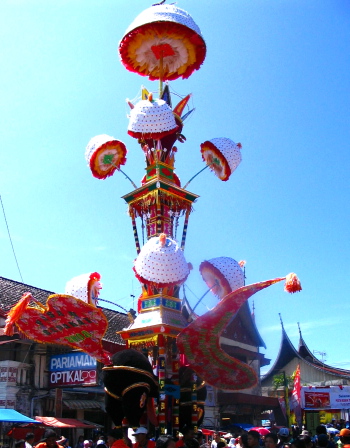Paul H. Mason
A tabuik cenotaph in the centre of Pariaman cityPaul H. Mason |
People from the hinterland region of West Sumatra say that the coastal region is rich with legends, mystical beliefs and Sufi traditions. These traditions are indigenous creations blended with adaptations of performances from neighbouring regions and abroad. The yearly festival of Tabuik in the coastal city of Padang Pariaman is a popular example of such a blend. It is a fascinating religious festival with local and foreign elements that reflect the diverse influences brought by the region’s history.
Tabuik is the remembrance of the martyrdom of the grandchild of the Prophet Muhammad, Imam Hussein, who died in the battle of Karbala in 680 CE. Around the world, Hussein’s ordeal is remembered through theatrical re-enactments, processions, public self-flagellation and religious rites. In Indonesia, however, Hussein’s struggle is recalled through diverse performance and ritual traditions, including dance and body percussion.
In Padang Pariaman, the re-enactment of the suffering of Hussein at Karbala has become an annual cultural event. On the tenth day of Muharram, the first month of the Islamic calendar, the anniversary of Hussein’s death is commemorated. The resulting celebration promotes social cohesion and regional identity, as well as tourism and trade.
Procession, submersion and destruction
Two of Padang Pariaman’s communities actively participate in the Tabuik procession. The Pasar and Subarang communities come from different areas of Pariaman. Through their efforts, the Tabuik tradition has become famous throughout West Sumatra, although it has not always enjoyed steady growth. In contemporary times, the government steps in to carry out much of the organisation of the event.
The tabuik itself is an upright, standing coffin built from bamboo, rattan, cloth and paper, decorated with eight umbrella-sized, handcrafted flowers. It is placed above a statue of a borak, a powerful steed with broad wings and the head of a smiling girl. A tabuik edifice has three levels and can exceed 15 metres in height and 500 kilograms in weight. The base level features long wooden poles that enable a group of men to carry it while dancing and performing a mock-battle with another tabuik.
 |
The construction of the tabuik takes ten daysKaja Dutka |
According to legend, a borak collected the scattered parts of the bodies of Hussein and his brother Hasan after the battle of Karbala and carried them to the sky. One version of the story says that during Hussein’s ascent to heaven, one of his followers asked the borak to carry him off as well. In another version, a sepoy ancestor managed to hang on to the chariot as it began its ascent to heaven. In both versions, the borak denied the devotees’ wishes to make the journey with Hussein, and ordered them to build a tabuik every year to commemorate Hussein's death.
Commencing on the first day of Muharram, two tabuik cenotaphs are assembled in preparation for the final procession. Construction begins with the collection of earth from Subarang and Pasar land. This earth is wrapped in white cloth and later put into the tabuik to represent the graves of Hasan and Hussein. Special rites accompany the making of the tabuik. These rituals represent different parts of Hussein’s story, and symbolise his courage in fighting the enemy, as well as the courage of his son, Abi Kasim, who avenged his death. The rituals are accompanied by community events, kite races, traditional plays, speeches by political and social leaders, various prayers, martial arts performances and Sufi dances. While the rituals generally involve select groups, the accompanying entertainment builds excitement among the broader community in anticipation of the procession of the two tabuik.
On the tenth day of Muharram, the procession is officially opened with traditional performances including the Gelombang welcome-dance, the Indang seated dance, and a martial arts performance that presents the story of Hasan and Hussein in theatre. The procession of the two tabuik follows. They are turned in circles and their umbrellas are shaken as the bearers, approximately twenty for each tabuik, rock them in a mock conflict symbolising the battle of Karbala. They proceed from the city centre to the beach accompanied by loud barrel-drums, hand-held kettle-drums, and synthesiser music called organ tunggal.
At the end of the journey, which occurs just before the evening prayer, both tabuik are thrown into the sea. What the waves don’t destroy is pulled apart by the people themselves, for the destruction of the two tabuik symbolises both the end of the battle and the ascent of Hasan and Hussein to heaven. Some people wade into the water in search of souvenirs of the destroyed cenotaphs.
The tradition continues
According to some authorities, the Muharram ceremonies originate from tenth century Shiite traditions in Iran. But the earliest roots can be traced even further back to pre-Islamic Persian legends involving themes of redemptive sacrifice and the veneration of deceased heroes. Regardless of its exact origins, the tradition has undergone numerous transformations within the diverse cultures and ethnic groups in which it has been nurtured. Muharram commemorations found throughout the Islamic world all display their local distinctiveness. The destruction of the tabuik in the sea, for example, appears to follow the Hindu custom of immersing a deity after a religious festival.
 |
The tabuik is thrown into the ocean as onlookers crowd the beachKaja Dutka |
Sepoy Indians from Madras and Bengal brought the Muharram rituals to the western coast of Sumatra. Shiites composed only a minority of the sepoy troops under the command of British colonial powers. The tabuik ritual, however, proved to be popular among the expatriate and Minangkabau communities. When the western coast of Sumatra was handed over to the Dutch after the Treaty of London was signed in 1824, sepoy troops remained. They carried on the Shiite tradition. Had the British retained control over the region, they would most likely have attempted to extinguish the festivities, for they believed the ceremonies were connected to Islamic secret societies.
Under the Dutch, Tabuik continued and prospered. Some Indonesian scholars have suggested that the Dutch provided funds for the ceremonies in order to create unrest, trigger quarrels between Islamic groups, and weaken the resistance of the West Sumatrans, although evidence for these claims is minimal. For a brief period, the festival’s commercial value attracted sponsorship from local businesses, mostly from Chinese traders. Nowadays the event enjoys sponsorship from the local government and the Department of Tourism, both of which have supported the inclusion of traditional Minangkabau performances in the festival.
Festival participants hold numerous interpretations of the event. Some suggest Tabuik is a re-enactment of the conflict between the brothers Isaac and Ishmael in the Islamic version of the story of Abraham. Others suggest that the two cenotaphs symbolise tensions between the different subdistricts of Pariaman city. In this interpretation, they represent discord between the richer and poorer parts of the city. The social tensions between the two subdistricts are symbolically expressed in the mock battles, and then ‘thrown out’ to sea. Some locals say this brings peace and cohesion to the Pasar and Subarang communities.
Muharram ceremonies are observed all over the world. Sometimes they attract interest from tourists. Sometimes they gain bad press by being associated with boisterous parades, self-flagellation, and occasional violence. In the city of Pariaman, however, Muharram ceremonies are peaceful and lively celebrations that unite communities. The history is so diverse, and the contemporary local element is so strong, that people happily embrace many differing interpretations. Not all the visitors to the Tabuik ceremonies are aware of the legend of Hussein or the ritual’s connections to Shiite and pre-Islamic conventions. Many people will more readily recognise the national and regional cultural references that government sponsorship has brought to the event. Visitors enjoy an experience conveying Minangkabau distinction as well as shared Indonesian tradition, validating the celebrations as regional heritage and national culture.
Paul H. Mason (paul@sobriquet.net) is a PhD student in the Department of Anthropology at Macquarie University. He would like to thank Pak Indra Utama from the Dance Department at the Indonesian Performing Arts College (Padang Panjang) who assisted him with fieldwork, the Polish photographer Kaja Dutka for her beautiful photographs, Professor Margaret Kartomi for background materials about Tabuik, and the ANRC for the opportunity to perform archival research at the KITLV in Holland.
